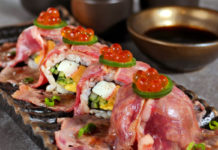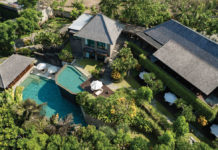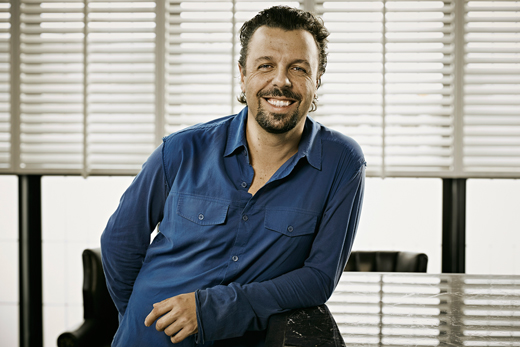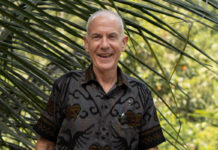Following on from the success of the hotel’s other outstanding new restaurant, Seminyak Italian Food, The Plantation Grill by Robert Marchetti has finally opened its doors following months of anticipation. Unsurprisingly, Asia Dreams is thrilled at the prospect of dining at Marchetti’s exciting New York-inspired seafood and meat grill and spending some quality time getting to know one of the region’s most creative and inspirational restaurateurs.
After the pleasantries, a cocktail or two and a guided tour of the opulent new bistro, it’s down to business…
Q: Although newly opened, The Plantation Grill, like Seminyak Italian Food before it, is the talk and toast of the town – are you happy with how it’s going so far?
A: Yes, I’m very happy, it’s actually working really well for us … and we’re having fun! I’m all about selling sensory experiences, creating something that triggers your brain and so, yes, I’m really comfy with what we have created here at Double-Six. Look around; I wanted all the spaces to be a social and fun experience offering great food and drinks – that’s exactly what we have created.
Q: The Plantation Grill looks amazing, the sounds and smells, the glitz and glam are fabulous… but for you, what’s it all about really?
A: Most of all I want dining out to be a sociable experience that feeds your senses. The visual impact from the action and flames at the grill as you come in, the décor, the smell of the food and drink, the sound of the upbeat music, the chatter and laughter of our customers, even the feel of these leather chairs add to the tactile interest. I create indulgent combinations that flatter and stimulate, so that’s what The Plantation Grill is all about.
We also offer big menus with lots of choice, so regular visitors have a range of dishes they can always enjoy, or new ones to try, and I want it to be accessible to everyone, from grandmothers to kids. There’s no kids’ menu, of course, but the food served can be enjoyed by kids too – we can do a small minute steak, hand-cut fries, a piece of fish, for example. If they are here, I want them to eat well and enjoy it; and I never forget the kids are my next generation of clients!
Q: To create a restaurant like this must be a complex and complicated affair – so how does an extraordinary concept like this begin?
A: Sure it’s complicated, but for me it starts simply with the menu. In fact, that’s always the anchor point for all my work in restaurants and bars. But it must be a democratic menu, a menu that works for all. I don’t put items on there that people don’t understand, or use descriptions and words because they are flashy or make you feel important. When I write a menu, I think, “Is my mother going to be able to navigate this?”
The right menu is an important element of success, and serving a wide audience can be very tough. If you want to have lots of regulars, you also have to maintain the right balance between new items and the sacred dishes that will never come off the menu. Here, the prawn cocktail, the profiteroles, the dry-aged T-bone, lobster thermidor, they will never come off; then we play with the seasonal items to create variety and expand the sensory experience.
The concept is simple really; it’s the detail that’s complicated. As soon as you walk in, I want you to see and smell the grill because the aroma and the flames involve people emotionally, so in this way the food is always the design brief, the first item on the agenda.
Q: The attention to detail seems incredible, are you involved in every aspect?
A: Yes, as well as the physical restaurant design I’m also into minute detail, such as spacing between tables and lighting levels, the shoes, the jewellery, the clothes and all the decor and accents. It was all custom designed and made to achieve my vision of what The Plantation Grill would become. Restaurants to me are the whole package – just look at this hand-stitched rug we’re bringing in [showing us a photo]. It’s taken four months to complete and will be the only colour in the black and white bar. Justine Missen designed this rug for us, and created the paintings in the Sling Bar too; but I always know what I want and give a really clear and full brief to my design team.
Q: That must be incredibly refreshing, and yet challenging too, for the people who work on the design.
A: Well, I always work with people who are elastic and who can understand my vision; and we have a lot of long-term collaborators – photographers, decorators, sculptors, for example, who buy in readily to my vision.
Everything is a challenge. Even the leather bar chairs we’re sitting on were made from scratch. I drew them and provided complete style specifications. To be the best, you have to do this in Indonesia; there’s no catalogue and so everything in The Plantation Grill is custom made; it took us two years to get here!
So the key to success is good creative collaborations. I bring all the right people aboard and work with friends to create individual concepts. You can’t design one of these and then copy it and make another five; the detail involved would drive you insane. Take the Plantation Girl theme – it’s a story, it grabs your interest, but it takes time and is unique.
Q: The overall design concept and realization is quite stunning, but where did idea come from?
A: Honestly, I’ve had this idea in my head since I was 24.
I get a lot of inspiration from movies and the two key movies for this place were Goodfellas and Tropicana. When the central character walks into Tropicana and in the middle of the room there’s the table with the cloth, the waiters snap into role, the champagne bucket is bang in place – it’s clubby, it’s fun, It’s classic theatre and it’s total engagement.
I always think all the best restaurant scenes are in films and that set designers design the best restaurants. Think about it, when Woody Allen does a restaurant scene, you want to know where that restaurant is – you want to be in that scene, you want to be at that table.
So here at The Plantation Grill, every detail, from the coasters to the costumes, is the same, we think like a set designer… Look, the coaster says this is elegant, the boys’ shorts say this isn’t fine dining, the table lights say everyone has a tan and is beautiful. Everything has a story that had to be manufactured and brought to life; it’s all in the detail. For example, we found this cork material and Justine and I did a little design to print on it [the coaster] and suddenly you’re telling a story, it’s interesting and not just some water in a cheap glass.
The idea is, you can come in here and have a couple of drinks and a steak sandwich, which by the way is magnificent! You’re part of the story…
Jamie, my music director, asked me if I thought all the people coming in would get the story I’d just spent an hour telling him by coming in to The Plantation Grill, and I told him yes, absolutely, they don’t need to know all the steps, they’ll simply get the magic.
Q: The last few years have seen you involved in a large number of projects not only here at Double-Six. How do you maintain the focus and above all the originality?
A: In project terms, I’ve actually been very selective about what I’ve said yes to. In the last three years, I’ve opened four or five restaurants and eight bars. There were a range of venues within venues – restaurants, bars, lounges, cafes and clubs. If you’re really disciplined about how you spend your time, like me, you can do all this and still have plenty of time for yourself.
As for originality, I just continually have ideas. If I got on a plane tomorrow, by the time it landed I would have a bunch of thoughts and they would go into a working file for a later date. I make notes and take photos of things that catch my eye; it might be a really cool thing but not suit what I have on the go now. Instead it will be perfect for something in the future. My menu ideas are usually from bad food experiences. “It’s just a bowl of mussels! Damn it….. I’m doing mussels!”
Q: It’s all really intense yet you seem very relaxed. How does Robert Marchetti unwind?
A: I have plenty of time to do anything I want because it’s how I’ve structured my business. I have nobody telling me how to do things and where to do them. I produce results and do so my way, which is something I learned from cooking.
Just today, I was up early for a call to America, so I had a swim and then meditated. After that I surfed and had a massive breakfast when I got home. After that I went out to a friend’s canteen and had another breakfast, came home and worked. Followed that with a late lunch with another friend, before I went home again, had a sleep, then a swim, before heading here for this evening.
Q: Any last thoughts about the future? Another Plantation Grill in Jakarta perhaps?
A: When anyone asks me if I’m going to do another of these somewhere else, I just say let’s get this right first and then move on. The fun factor is the most important thing, plus it has to be with people like Kadek, where there’s total trust.
As for projects, I love movies and Stephen Sonnnenberg is my favourite film director; he sums up his film making really succinctly, saying, “Every time I make my next movie, I think it’s going to be my first failure.”
Truth is, I think that it’s healthy, depending on how you deliver it, to have that sense of anxiousness about whether you can pull it off or not. Richard Branson’s quote is: “If your next project doesn’t scare you, then it’s not big enough.”
Small restaurants take as much work as a big one, the way I work, and when I committed to this, I said to Kadek that if we’re going to do this we have to think like restaurateurs, not hoteliers – none of the brown and beige and so I’ll say it again, let’s get this right first and then move on.























